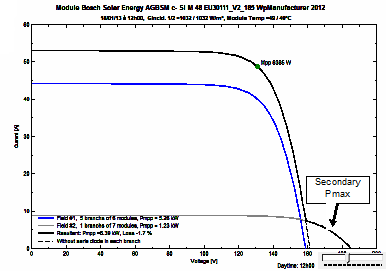-
Posts
2072 -
Joined
-
Last visited
Everything posted by André Mermoud
-
I don't know how you obtained this curve. But of course, it is strongly dependent on the reverse charactersitics of the shaded cell. When I tried to establish experimentally this little (very rough) quadratic model by forcing a fixed reverse voltage to the cell, the measurements were difficult as when heating up, the cell's conductance increased with the temperature, therefore dramatically increasing the current and so on up to the destruction if I did not disconnect within some few seconds. It is probable that your shaded cell's voltage saturates at around -10 V or -11V, and this will indeed result in your observed curve. However this tool is a pedagogical one (for explaining the phenomenon). Fortunately the exact behaviour in this region doesn't arise in the real life, due to the protecting diodes. Otherwise you would often have cell's destructions due to Hot-spots !
-
This is related to the font size you are using in your Windows installation. Choosing "Small fonts" in your Windows installation should in principle solve the problem. If not please see Problems in the report format
-

Can I put two brands of modules in the same inverter?
André Mermoud replied to emiliosolar's topic in How-to
No, in PVsyst each MPPT input (each sub-array) should be homogeneous (same module kind, same number of modules in series). -
Please see in the FAQ : How to use inverters with very different MPPT (like Tripower of SMA) NB: In the new version 6, you have the opportunity of defining explicitely such a configuration (i.e. a "Main" and a "Secondary" input) with the concerned inverters.
-
In the "Orientation" part, please choose "Fixed tilted plane" and you can define the tilt and azimuth. There is no difficulty.
-
If you have a "normal" grid at disposal, a stand-alone system is usually not very useful (not economically optimal). Now except grid, there are no much uses of the excess electricity (you could heat up water for example). Please see my comment about hybrid systems in the FAQ : Can I include a battery in a grid-connected system ?
-
You can import meteo data in ASCII for one only day (24 hours), it is the lower limit.
-
In PVsyst, the definition of the user's needs is specified in terms of energy. Now this energy may be used in any way. Either directly by DC appliances, or by AC appliances after an inverter. The load energy specified in PVsyst is the DC energy before the inverter. If you want to use an inverter you should estimate externally the required DC energy, taking the efficiency and the stand-by losses into account. In fact the main information expected from the Stand-alone systems simulation is the energy balance between the PV production, the battery storage and the energy use (including a possible genset). The inverter is not an essential point in this evaluation. An inverter for a stand-alone system is a completely different device than an inverter for grid-connected systems: - For a grid-connected system, the input performs the MPP tracking on the I/V curve of the PV array; and at any time, the converted power is determined by the suns' availability. - For a stand-alone system, the input works at fixed-voltage (the battery voltage) with an "unlimited" current or power; the power is according to the instantaneous user's needs. We have deeply renewed the treatment of the Stand-alone systems for the version 6.40. Inverters devices will be defined soon. This requires to define a new component type, and the corresponding database.
-
This depends on which kind of data you are importing. If you import Monthly values, you have to choose the time zone in the "Site" definition, and this will be used for the generation of synthetic hourly data. If you import hourly values: - either you import them from a "known" source referenced by PVsyst, and the Time Zone is usually mentioned in the header of the file read by PVsyst. You don't have to define it by yourself (exception: the helioclim hourly data don't mention it if I remember well). - or you import them from another kind of ASCII file, and you have to define the Time Zone in the associated Site file which defines the geographical coordinates. In this case be carteful: the chosen time zone should be closely related to the time steps of the ASCII source file. In the format protocol, you can choose whether le time stamps of the data source represent the beginning or the end of the interval. After such import of data, please carefully check the time of you data by respect to the internal time of PVsyst (i.e. the clear day model), using "Meteo tables and Graphs" / "Data quality check". NB: As with most of the meteo data, PVsyst doesn't take the DST (Daylight Saving Time) into account, and people usually choose the Winter time as reference. You have a map of the Time Zones over the world at http://www.worldtimezone.com/ as well as a summary of DST situations and dates on the same site http://www.worldtimezone.com/daylight.html Now PVsyst fixes limits to the differences between Legal Time and Solar Time, for avoiding rough errors. It accepts differences from -1 to +2 hours. If in some special cases these limits should be overcome you can modify them in the "Hidden Parameters", topic "Miscellanaeous".
-
When in "Tools" / "Inverter" database, you have a button "New". The easiest way: choose an existing inverter (analogous to yours), modify the parameters according to your datasheets, and save it under another name, thus creating a new component in the database. The filename is the "primary Key" of each database element. I have taken the convetion to define it as "Manufacturer_Model.OND".
-
In PVsyst V 5, for historical reasons only the lower tolerance is specified. If positive tolerances, the lower value is set to 0.1 as the 0 value is interpreted as "not defined" and set to 3%. This value is only used as initial default value for the "Module Quality Loss" factor. Now the datasheets may change at any time. Many manufacturers who previously defined -3/+3% have recently passed to positive sorting (-0/+3 or +5%). Rserie and Rshunt are specific parameters of the one-diode model, not specified in the datasheets. In absence of specified values PVsyst chooses default values. See How to fix Rserie and Rshunt parameters? and their implication in the simulation results.
-

Simulating 2 strings with different number of modules
André Mermoud replied to SoftwareTester's topic in How-to
You can't do that in PVsyst. This is not a good system in the reality. The strings connected to a given MPPT input should be homogeneous. The 2 inputs of the inverter are just connectors. They are connected together in the device. NB: however you are partially right: with only 2 or very few strings the mismatch is not so important. But in the tool "Electrical behaviour of the heterogeneous arrays", try for example to define 37 modules as 5 x 6 modules and 1 x 7 modules: you will see a secondary Maximum power point, and the MPP tracker may clip on it, and never reach the true MPP ! -

Difference between PVSyst PR and PVWatts derate factor
André Mermoud replied to lucied's topic in Simulations
I don't know the exact definition of the Derate factor of PVWatts. But finding a different value between both values doesn't mean that they are differently defined. The PR of PVsyst involves the result of the full simulation. If PVWatts performs a different simulation and gets a different result, its indicator will be different of course... -
I have never seen any article nor publication about the ageing of the inverters. I heard that we we can wait MTBF (Mean Time Before Failure) of the order of 15 years as an average with the modern devices, but nothing about degradation. If someone has some information about this subject, thank you for sharing it ...
-
The simulation report is not modifiable nor editable. This ensures that nobody can alterate the output data of PVsyst. However this is a good idea, I could offer the possibility of choosing alternative monthly plots proposed on the report. I will think about such an opportunity for a next version. The present graphs are in an "official" format as proposed by recommendations of the JRC (Joint Resarch Center), the PV lab of the European Communities. And specified in the IEC/TS 61836 norm.
-
In the "System" definition dialog: Top left, please define "2 kinds of Subfields". After that you can define 2 kinds of Array dispositions, i.e. use different MPPT inputs of the same inverter in both sub-arrays. If you have for example 2 inverters with 2 MPPT inputs each, as you mention, you can define a first sub-array of 2 MPPT inputs with a given string length (number of modules in series), and a second sub-array with 2 MPPT inputs and another number of modules in series. Now if your problem is that the Inverter has unbalanced MPPT inputs, please have a look on How to use the inverters with very different inputs like SMA Tripower?
-
An ASCII file is simply a text file. Any *.TXT, *.CSV, *.PRN and so on, opened or issued by EXCEL or Notepad. Now if you have data in monthly values, you should directly define a new site ("Tools" / "Geographical sites" / "New"). Here you define the geographical coordinates (latitude, Longitude, Altitude, Time zone) and on the second page you can "copy" the monthly data in EXCEL and "Paste" them here (necessary data: Global horizontal and Ambient temperature".
-
Please see the help "Project design > Results > Simulation variables ... " Some variables are not mentioned here, I have to update these pages with variables newly introduced ...
-
The simulation always uses the one-diode model, but at any irradiance and temperature conditions. The effectve Pmpp at STC (or nominal efficiency) is never used as such. The model doesn't rely to any "nominal" efficiency value.
-
For the pre-sizing part: this is a parameter specifiecd in the Hidden patrameters. For the System design part: this is indeed a result of the simulation. The hourly simulation will cut the load when attaining a given Voltage low threshold, defined in the Controller parameters, and related to the behaviour of the whole system at each time (exactly as in the reality). The DOD will depend on this threshold, and you can see it in the Hourly plots, when plotting the state of charge as function of the time. NB: In a future version I intend to deeply revise the Stand-alone systems treatement, and I will probably give the opportunity of defining a DOD as parameter for the Controller instead of a voltage threshold. However I think this strategy is not yet much implemented in real commercial controllers, as the accurate evaluation of the SOC of a battery pack by the Controller (i.e. Ah balance and real capacity evaluation) is a difficult task ...
-
First, I observe that your values are quite close. However I can make several comments: - A model is never the reality. Especially the one-diode model is highly non-linear. You establish it at STC (1000 W/m2 and 25°C) and at other conditions (derived from the model), with probably rounding errors in the Isc, Voc, Imp, Vmp values. Therefore this is not exactly the same model's parameters. - The true Pmpp value is not perfectly linear with the temperature: that is, muPmpp it is not constant with the temperature. This is a result of the model, and also the reality (please have a look on official measurements reports of TÜV or others if you avail). - The muGamma correction is a little "ad hoc" correction just for matching the muPmpp of the model to the specified value. In you case a discrepance of 0.04% to -0.07% is really very low. Personally, I am really surprised that the one-diode model behaves with such an accuracy in this case !!!
-
BIPV double glass modules behave in the same way as usual modules. I think you are talking about Bifacial modules, which are able to produce electricity from both sides of the cells/module. Please see my answer to the post Mono c-Si Bifacial modules
-

Can you override the active area to collector area ratio?
André Mermoud replied to EllenTB's topic in Shadings and tracking
Yes. the limit is in the hidden parameters. In the main menu, option "Preferences" / "Edit Hidden parameters" / "Detailed Simulation Verification Conditions", topic "Shadings: Absolute maximum Shadings/Field Area ratio". -

Problem with generating Meteo file from ASCII file
André Mermoud replied to Hafiz's topic in Meteo data
Yes of course, the sample is not sufficient. This test is meant for a one-year dataset, it compares the best days in the data with the clear day model for getting an estimation of the quality of the data (namely the solarimeter calibration). For the discrepance between data, please see the help of PVsyst: "Geographical and Meteorological data > Import from Meteorological data sources: Meteorological data comparisons". -
There is no possibility of deleting components or meteo files in PVsyst. You should explicitely delete the concerned files (*.MET and *.SIT) in the folders c:\ProgramData\PVsyst\Data\Meteo\ and ...\Sites\ Please have a look on Where are stored my working data in PVsyst ?


